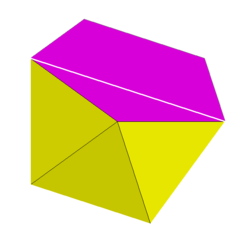| Uniform Pentagonal antiprism | |
|---|---|

| |
| Type | Prismatic uniform polyhedron |
| Elements | F = 12, E = 20 V = 10 (χ = 2) |
| Faces by sides | 10{3}+2{5} |
| Schläfli symbol | s{2,5} |
| Wythoff symbol | | 2 2 5 |
| Coxeter-Dynkin | |
| Symmetry | D5d |
| References | U77(c) |
| Dual | Pentagonal trapezohedron |
| Properties | convex |
 Vertex figure 3.3.3.5 | |
In geometry, the pentagonal antiprism is the third in an infinite set of antiprisms formed by an even-numbered sequence of triangle sides closed by two polygon caps. It consists of two pentagons joined to each other by a ring of 10 triangles for a total of 12 faces. Hence, it is a non-regular dodecahedron.
Geometry[]
If the faces of the pentagonal antiprism are all regular, it is a semiregular polyhedron. It can also be considered as a parabidiminished icosahedron, a shape formed by removing two pentagonal pyramids from a regular icosahedron leaving two nonadjacent pentagonal faces; a related shape, the metabidiminished icosahedron, is likewise form from the icosahedron by removing two pyramids, but its pentagonal faces are adjacent to each other. The two pentagonal faces of either shape can be stellated to form the icosahedron.
Relation to polytopes[]
The pentagonal antiprism occurs as a constituent element in some higher-dimensional polytopes. Two rings of 10 pentagonal antiprisms each bound the hypersurface of the 4-dimensional grand antiprism. If these antiprisms are stellated into pentagonal prism pyramids and linked with rings of 5 tetrahedra each, the 600-cell is obtained.
See also[]
- Set of antiprisms
- Octahedron Triangle-capped antiprism
- Square antiprism
- Hexagonal antiprism
- Octagonal antiprism
External links[]
- Weisstein, Eric W., "Pentagonal antiprism" from MathWorld.
- Pentagonal Antiprism: Interactive Polyhedron Model
- Virtual Reality Polyhedra www.georgehart.com: The Encyclopedia of Polyhedra
- VRML model
- Conway Notation for Polyhedra Try: "A5"
| This polyhedron-related article is a stub. You can help Math Wiki by expanding it. |
eo:Kvinlatera kontraŭprismo